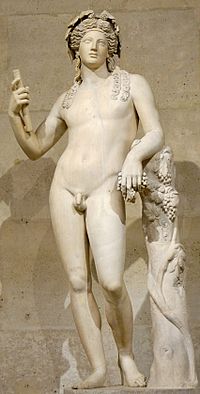|
Greek city of Temnos in Aiolis
Bronze 18mm (3.01 grams) Struck circa 50-150 A.D.
THMNOC, Draped bust of turreted Tyche right.
THMNΩΤΩΝ, Tyche standing left, holding rudder and cornucopia.
* Numismatic Note: This is a very
rare, possibly unpublished type from Temnos in Aiolis.
Situated a short distance east of Neonteichos, on the hill-side above the right
bank of the river Hermos.
You are bidding on the exact item pictured,
provided with a Certificate of Authenticity and Lifetime Guarantee of
Authenticity.
Dionysus or
Dionysos (Greek
Διόνυσος) is the
ancient Greek
god of the grape harvest,
winemaking and
wine, of ritual madness and
ecstasy, was also the driving force behind
Greek theater. The god who inspires joyful
worship and
ecstasy, festivals and celebration is a major
figure of
Greek mythology and the
religion of ancient Greece. He is included as
one of the
 twelve twelve
Olympians in some lists. Dionysus is typical of the god of the
epiphany, “the god that comes”. He was also
known as Bacchus, the name adopted by the
Romans and the frenzy he induces, bakkheia.
Hailed as an Asiatic foreigner, he was thought to have had strong ties to the
East and to
Ethiopia in the South. He was also known as the
Liberator (Eleutherios),
freeing one from one’s normal self, by madness, ecstasy or wine. The divine
mission of Dionysus was to mingle the music of the
aulos and to bring an end to care and worry.
Scholars have discussed Dionysus’ relationship to the “cult of the souls” and
his ability to preside over communication between the living and the dead.
In Greek mythology, Dionysus is made out to be a son of
Zeus and the mortal
Semele. He is described as being womanly or
“man-womanish”. The
retinue of Dionysus was called the
thiasus and was composed chiefly of
maenads and
satyrs. Dionysus is a god of
mystery religious rites. In the
Thracian mysteries, he wears the bassaris
or
fox-skin, symbolizing new life. His own rites, the
Dionysian Mysteries practiced by
maenads and others, were the most secret of
all. Many scholars believe that Dionysus is a
syncretism of a local Greek nature deity and a
more powerful god from
Thrace or
Phrygia such as
Sabazios or
Zalmoxis.
Contradictions in Dionysus’ origin suggest to some that we are dealing not
with the historical memory of a cult that is foreign, but with a god in whom
foreignness is inherent.
Karl Kerenyi traces him to
Minoan Crete, where his Minoan name is unknown
but his characteristic presence is recognizable. Clearly, Dionysus had been with
the Greeks and their predecessors a long time, and yet always retained the feel
of something alien.
Temnos (also Temnus) was a small Greek city-state, on the
western coast of Anatolia. The name survives as a Catholic
titular see. When Temnos was a functioning
diocese, its bishop was a
suffragan of
Ephesus.
Temnos was a little town of
Aeolia, near the
Hermus River, which is shown on its coins.
Situated at elevation it commanded the territories of
Cyme,
Phocaea, and
Smyrna. Under
Augustus it was already on the decline; under
Tiberius it was
destroyed by an earthquake; and in the time of
Pliny it was no longer inhabited. It was
however rebuilt later.
|





 twelve
twelve 


